Hawaii is the vacation destination of choice for many people you may find traveling. With white sandy beaches and clear tropical waters, there’s no place better to relax. Unless, of course, you know all about the sharks that lurk in the Hawaiian waters.
There are 40 different species of shark that can be found in the coastal waters of Hawaii. This shark diversity is due to the islands having warmer waters and being in the tropical area of the world.
Shark sightings are often rare, though, with many locals only seeing a few of the nondangerous sharks.
There are known to be eight sharks that are the most common in Hawaii, at least to the state’s official website. These eight sharks are:
- Blacktip Reef Shark
- Galapagos Shark
- Grey Reef Shark
- Sandbar Shark vulnerable
- Scalloped Hammerhead Shark
- Smooth Hammerhead vulnerable
- Tiger Shark
- Whitetip Reef Shark
Sharks are one of the natural predators of the ocean, though many of them have become vulnerable or endangered over the years due to habitats being infringed upon. Two of these eight species have been classified as vulnerable for their conservation status, and one is critically endangered.
Reef sharks are the overall most common shark in Hawaii because of all the coral reef habitats there are for them to thrive. Hammerheads are also common because of the coral reefs; their favorite food, the stingray, lives among the coral.
Blacktip Reef Shark
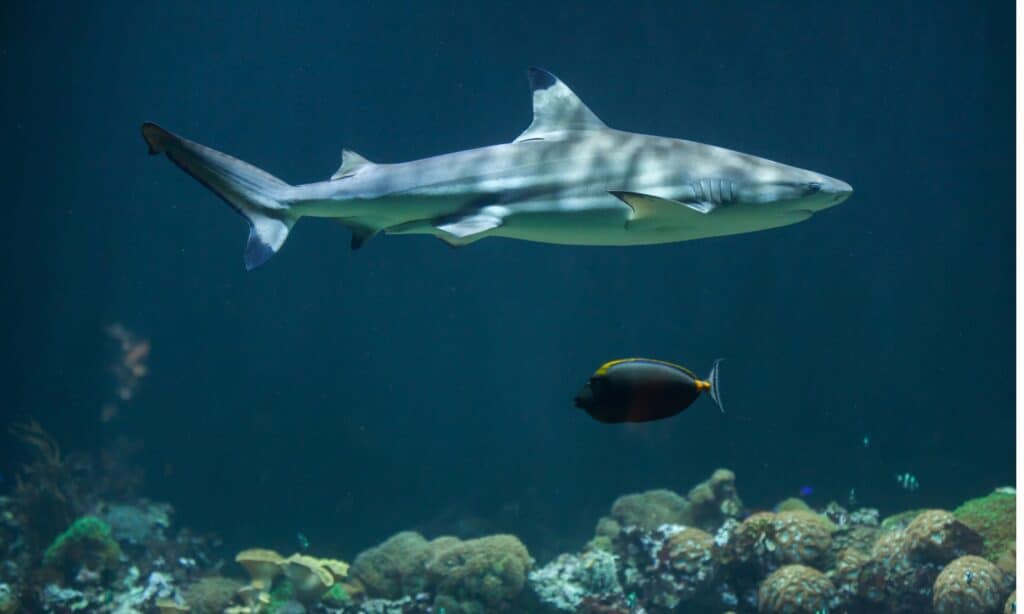
The blacktip reef shark is not an aggressive shark and swims close to shore.
©iStock.com/wrangel
This is not the same as a blacktip shark. These are a smaller species with similar black tips on their fins who live along coral reefs and in shallow waters. It eats crab, lobster, fish, squid, and octopus.
The blacktip reef shark is not very aggressive and swims very quickly away from noise and activity. This doesn’t mean it can’t bite, though, and bites happen as people swim in the same areas and startle them.
Swimming fully in the water instead of walking through it is a great way to dissuade any sharks that may spot you and think you’re food.
Galapagos Shark
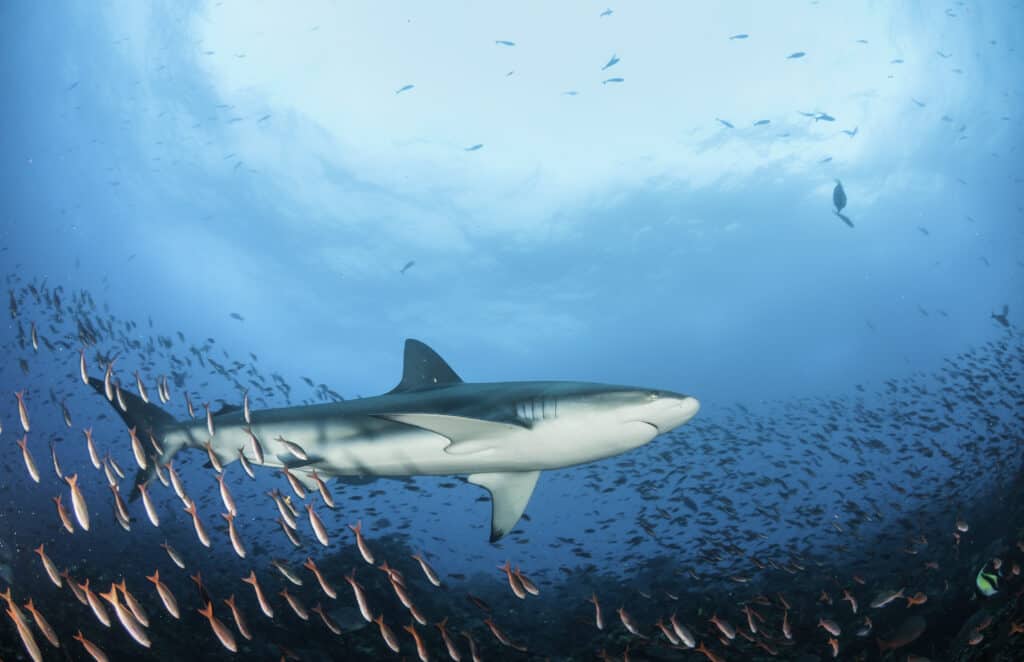
The Galapagos shark grows up to ten feet long.
©wildestanimal/Shutterstock.com
The Galapagos shark can grow up to ten feet long and often may eat other sharks, including smaller ones of their own species. They are a common shark to dive with or swim with because they travel in large groups and are not supremely aggressive.
They are drawn to human activity but don’t seem scared or angered by their presence. When there are groups of fishers the Galapagos shark will show up en masse to satisfy their curiosity.
Not all sharks need to be feared by swimmers; we just need to be cautious and aware of our surroundings while swimming.
Grey Reef Shark
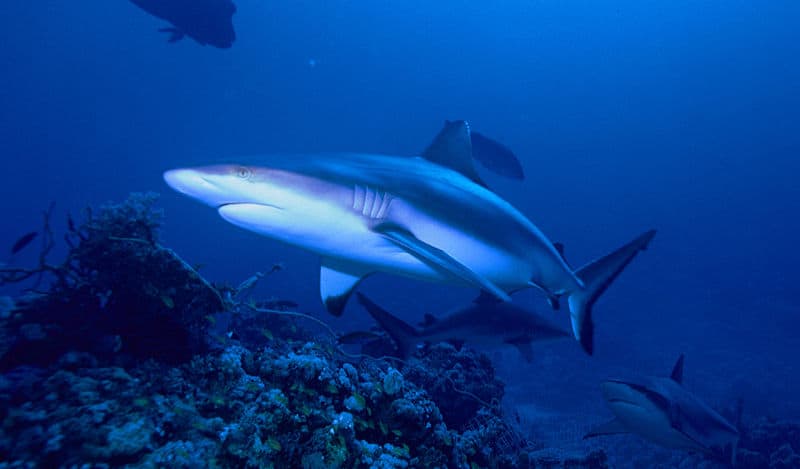
Grey reef sharks are more dangerous than some other sharks as they are more aggressive toward humans.
Grey reef sharks are known to be more aggressive toward humans. They tend to swim around the edges of coral reefs, searching for squid, octopus, and fish to eat. Grey reef sharks are socially aggressive within their own groups and tend to be curious about divers.
These sharks are active during all periods of the day, not at specific points, and tend to have the most of their traveling adventures during the night. If you are out fishing and they come around, they might try to steal your catch.
Sandbar Shark
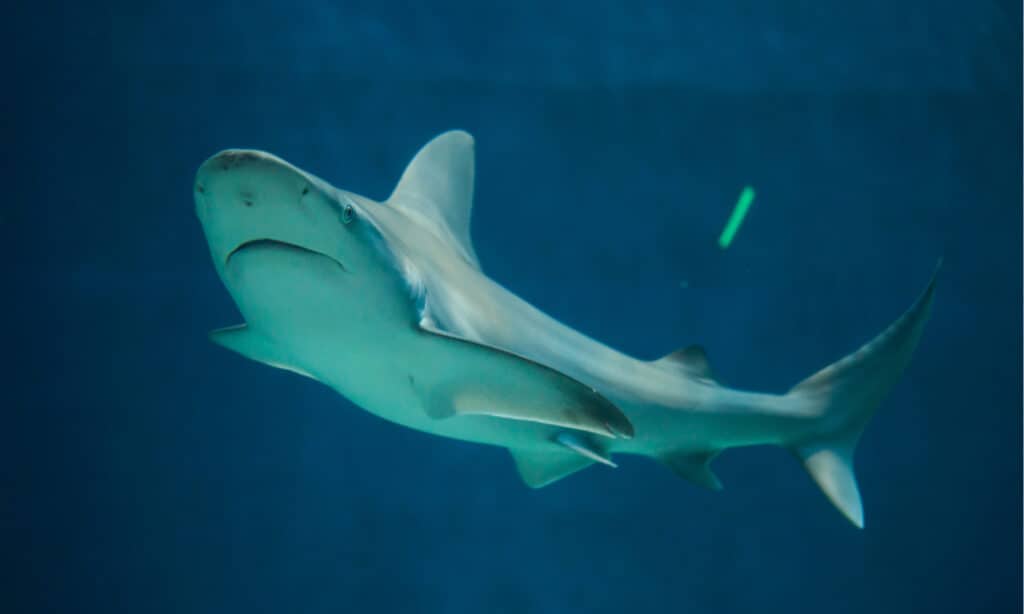
The sandbar shark has an abnormally large dorsal fin.
©Vladimir Wrangel/Shutterstock.com
The sandbar shark is classified as vulnerable, which means that the International Union for Conservation of Nature decided it was a species that could become extinct without proper regulation of habitats and fishing.
The dorsal fin of this shark, which peeks up above the water, is larger than the average shark, giving it a distinct appearance and a large short nose. They can grow up to eight feet long but do not often come near people and do not attack them.
They don’t have babies as often as other sharks, which is why they are classified as vulnerable.
Scalloped Hammerhead Shark

The scalloped hammerhead shark is critically endangered.
©Ian Scott/Shutterstock.com
Scalloped hammerheads are critically endangered because they are overfished for their fins. It enjoys spending its time in warm waters off the coast of Hawaii, and if they do not have enough fish to eat, their young are known to starve to death. That’s why they are so easily affected by being killed or changing their habitats.
They are called scalloped hammerheads because of the hammer shape of their head, and there’s are more rounded than the average hammerhead giving it more of a shovel scoop. Notches on either side make it look scalloped.
Smooth Hammerhead
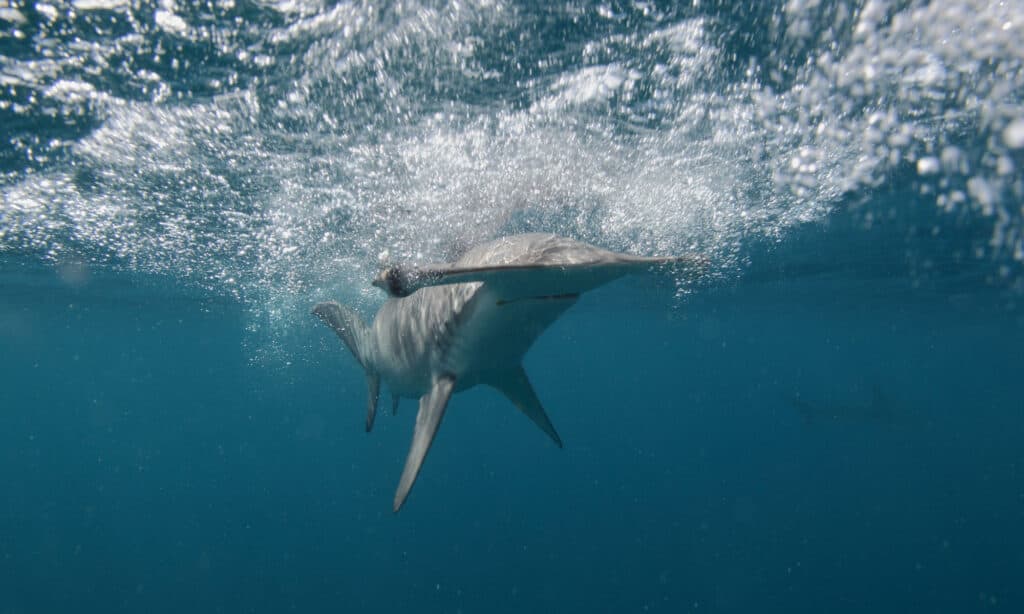
The smooth hammerhead is classified as a vulnerable status.
©Alessandro De Maddalena/Shutterstock.com
The smooth hammerhead is vulnerable, which means the populations are slowly decreasing, and they could eventually become critically endangered. Shark finning is a huge reason for their population decline, as their fins are popular for shark fin soup.
It is not a smart idea to potentially swim with these sharks as they are known to be aggressive and even steal fishers’ catches. They tend to eat stingrays, fish, and other sharks when the occasion arises.
They tend to be further away from the shores than other sharks, so it’s more an issue for divers and fishers than the average swimmer.
Tiger Shark
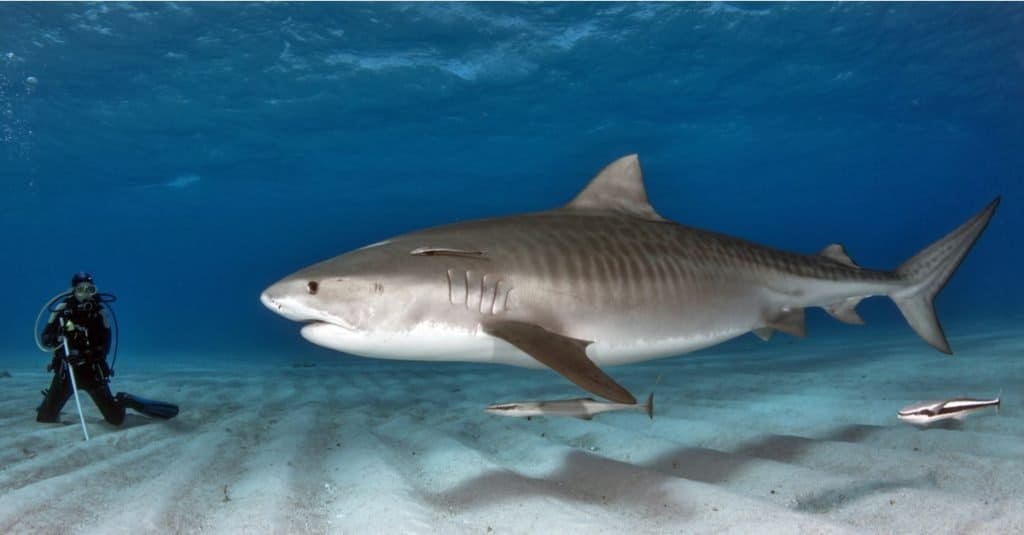
The
tiger shark
attacks humans unprovoked.
©Tomas Kotouc/Shutterstock.com
The tiger shark is known to be a rare type of shark in that it will attack humans unprovoked, whereas most sharks are more curious or scared than aggressive.
They are dark gray with black tiger like stripes along the main part of their body. This shark hunts at night, where it blends in more. They are responsible for most of the fatal shark bites which occur.
The tiger shark is an apex predator, which means its diet is varied. They eat fish, birds, squid, octopus, other sharks, dolphins, sea turtles, sea lions, and even old humpbacked whales.
Whitetip Reef Shark

The whitetip reef shark has white eyes with vertical, notched pupils.
©Rich Carey/Shutterstock.com
This reef shark is just as common as the blacktip and grey reef sharks but even less aggressive. They have white eyes with vertical pupils and shorter snouts. Their fins are tipped in white while their bodies are gray.
Their dorsal fin is positioned further back than average, giving them a distinct look. They like to lay down on the seafloor and rest, which isn’t something many sharks can do. Whitetip reef sharks eat fish, octopus, crabs, and smaller marine life.
Up Next
The photo featured at the top of this post is © iStock.com/Sean Craft
FAQs (Frequently Asked Questions)
How many species of sharks can be found around Hawaii?
There are 40 different species of shark that can be found in the coastal waters of Hawaii. This shark diversity is due to the islands having warmer waters and being in the tropical area of the world.
What are the most common sharks around Hawaii?
Reef sharks are the overall most common shark in Hawaii because of all the coral reef habitats there are for them to thrive. Hammerheads are also common because of the coral reefs; their favorite food, the stingray, lives among the coral.
Thank you for reading! Have some feedback for us? Contact the AZ Animals editorial team.






